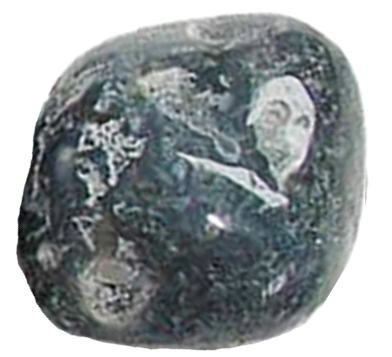
Moss agate is a captivating form of chalcedony that has long enchanted collectors, jewellers, and crystal enthusiasts alike. Celebrated for its unique, organic inclusions that resemble miniature foliage, moss agate has a rich history and enduring appeal that spans cultures and centuries.
Origins of Its Name and Alternate Names
The name “moss agate” originates from the stone’s distinctive appearance: translucent chalcedony featuring green, moss-like inclusions. These inclusions are actually mineral deposits—typically iron or manganese—that create patterns reminiscent of tiny, leafy plants. In some regions, moss agate is also known as “Verde Agate” or “Botanical Agate,” reflecting both its colour and natural, plant-like imagery.
Composition and Physical Characteristics
Moss agate is a variety of chalcedony, a microcrystalline form of quartz (silicon dioxide). Its translucency and milky base provide the perfect canvas for the intricate, vein-like inclusions that set it apart. The stone typically ranges in colour from light to deep greens, with shades of brown and even red sometimes present, depending on the specific mineral content. Its hardness on the Mohs scale is about 6.5 to 7, making it durable enough for everyday wear in jewellery while still showcasing a subtle, earthy elegance.
Varieties and Locations
Moss agate is found in various locations around the world. Significant deposits have been discovered in India, Brazil, the United States, and parts of Europe. Each locality imparts slight variations in the stone’s appearance. For instance, Indian moss agate is often noted for its vibrant green hues and intricate, well-defined inclusions, while specimens from the United States may display a more muted palette. These geographical differences contribute to a diverse range of moss agate varieties that are prized by collectors and artisans alike.
Archaeological and Significant Finds
Jasper-like stones, including agates, have been used by ancient cultures for millennia. Moss agate, in particular, has been found in archaeological sites where it was fashioned into decorative objects, amulets, and utilitarian tools. Ancient artisans valued its natural beauty and believed in its protective qualities, incorporating it into carvings and ritual items. These significant finds illustrate not only the aesthetic appeal of moss agate but also its historical role as a talisman and symbol of nature’s bounty.
Historical and Current Usage
Historically, moss agate was revered by ancient civilizations for its supposed healing and protective properties. It was often worn as a charm to ensure fertility, prosperity, and a connection to nature. In modern times, moss agate has retained its popularity as both a decorative stone and a gemstone for jewellery. It is frequently set in rings, pendants, and bracelets, and is also used in home décor items such as polished tabletops or ornamental carvings. Its earthy, natural beauty continues to appeal to those who appreciate its rustic charm and historical resonance.
Interesting Facts, Folklore, Legends, and Tales
Moss agate is steeped in folklore and legend. In many cultures, it is believed to be a stone of abundance and fertility, thought to bring prosperity and growth. Some legends claim that moss agate was formed when the earth cried, and its tears crystallised into the stone, capturing the essence of life itself. In other traditions, moss agate is seen as a symbol of eternal youth and rejuvenation, offering the wearer a constant reminder of nature’s cycle of growth and renewal.
Mystical Healing Properties
In the realm of crystal healing, moss agate is prized for its purported ability to promote emotional balance and harmony. Healers believe that the stone can ease anxiety, encourage a sense of calm, and foster an appreciation for nature. It is also said to stimulate personal growth and self-acceptance, acting as a grounding force during times of stress. Although these healing properties are based on metaphysical traditions rather than scientific evidence, many individuals report feeling a positive, nurturing energy when they work with moss agate.
Links with Astrology and the Zodiac
Astrologically, moss agate is often associated with the zodiac signs of Taurus and Virgo, which are known for their deep connection to the earth and practicality. Its earthy tones and organic patterns are believed to resonate with these signs, enhancing traits such as stability, perseverance, and an appreciation for natural beauty. Additionally, some practitioners link moss agate to the sign of Cancer, owing to its reputed protective qualities and its ability to nurture emotional well-being.
The Chakra System
Within the chakra system, moss agate is primarily connected with the Heart Chakra, which governs love, compassion, and emotional balance. Its gentle, grounding energy is thought to open the heart, encouraging empathy and a deep connection with nature. Some also associate the stone with the Root Chakra, as its earthy hues help to foster stability and security. This dual association makes moss agate a favoured stone during meditation and healing practices, aiding in the harmonisation of both emotional and physical energy.
Birthstone and Wedding Anniversary Connections
While moss agate is not traditionally included in the standard birthstone lists, its natural beauty and symbolic associations make it a compelling alternative for those born in spring or early summer—particularly in months when nature is in full bloom, such as May. Its themes of growth, renewal, and fertility also render it a meaningful gift for wedding anniversaries. As a wedding present, moss agate represents the flourishing of love and the promise of a bountiful future together, symbolising enduring harmony and the natural cycles of life.
